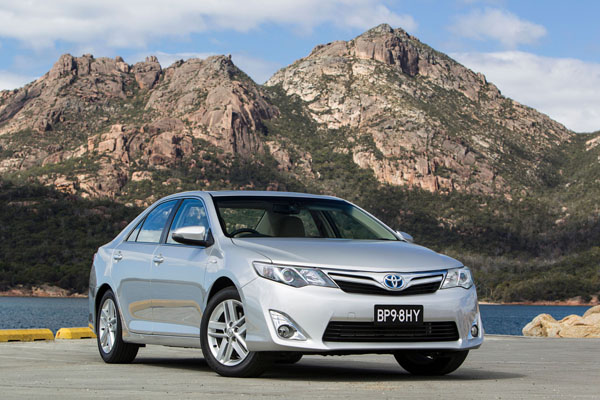
Toyota Camry is no longer built in Australia because the Altona, Melbourne factory was closed down in October 2017. An all-new fully imported Camry replaced the Australian one at that time.
The stylish new 2018 Camry created a lot of buyer interest and already many Camry owners have traded in their cars on it. Meaning dealers may have an oversupply of used Camrys and are keen to drop prices to shift them. No promises, though.
Toyota Camry has long been a major player here, first arriving in 1983 as a fully imported car, then built in Australia from 1987. In this review we will begin with the sixth generation that was launched in July 2006.
Toyota Camry and Aurion are medium-to-large family cars competing against Commodore and Falcon. Though slightly smaller than them Camry and Aurion have almost as much interior room due to the space saved by having front-wheel drive. Legroom is similar to that of the Holden and Ford, but rear-seat width isn’t as good.
As the Toyotas have front-wheel drive their boot is deeper because there’s no differential under the floor.
Some Camrys had been sold with a choice of four or six-cylinder engines until 2006, but from the gen-six the V6 model received a new title – Toyota Aurion.
Camry and Aurion have many changes from Japanese models to suit them to Australian driving conditions and Aussie drivers’ tastes. Basically, they have slightly firmer suspensions and the engines are tuned to give them added grunt lower down in the rev range.
The four-cylinder Camry engine was a 2.4-litre unit until the gen-seven of 2011 when a virtually all new engine, now with 2.5 litres was installed. The V6 used in the Aurion is a 3.5-litre that’s smooth and powerful with plenty of punch.
Automatic transmissions far outnumber manuals. The auto had five ratios till 2012 when a six-speed was introduced.
Toyota launched the Australian-built Camry Hybrid in February 2010. It used imported parts for the hybrid drive system that were installed in the locally made Camry body.
With more power and torque than the petrol Camry the hybrid had added performance, particularly off the mark with the electric motor developing maximum torque. Depending on where and how it’s driven the hybrid can use 10 to 40 per cent less fuel than a petrol car.
Toyota has arguably the most widespread of dealer networks in Australia with dealers in many remote areas due to its major presence in the 4WD and light-commercial fields.
Spare parts and servicing costs are generally reasonably priced and will continue to be sold here after local manufacture ceases.
Good home mechanics will find these cars are quite easy to work on. We recommend that amateurs always have a workshop manual on hand, and don’t touch safety related items.
As they are aimed at conservative buyers these Toyotas are often cheaper than fully imported car in this segment. There doesn’t seem to be much variation in price from insurer to insurer, but it’s still worth shopping around.
WHAT TO LOOK FOR
Run your hand over the front tyre tread – more resistance one way than the other means uneven tyre wear. That’s often caused by a wheel alignment problem, possibly caused by the car being thumped against a kerb.
Engines should start quickly and settle into a smooth idle within a couple of seconds.
Four-cylinder engines aren’t as smooth as V6s but if one seems too rough get a qualified mechanic or an inspector from your motoring association to examine it.
Automatic transmissions are smooth and any harshness at other under hard acceleration should be checked out by a professional.
Check over the condition of the interior in case the Camry has had a rough time at the hands (and feet) of uncaring kids. Similarly above average wear on the driver’s seat and/or boot may indicate commercial use.
Look over the complete body for damage, or for indications it has been repaired after a crash. If there’s any doubt either pass up on the car or have an expert appraisal.
Drive the car at low speed on full steering lock and listen for noises at the universal joints at the front wheels.
CAR BUYING TIP
Cars bought by government and private fleets may have been driven harder than normal. To partly balance that out they are usually serviced strictly by the book.